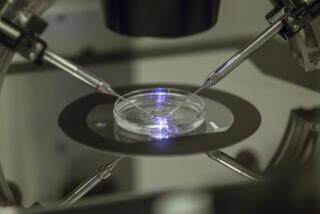Success Rate of Fertility Treatments Compared : Medicine: The results of 177 centers offering ‘test-tube fertilization’ and similar procedures in the U.S. are published for the first time.
In the first report of its kind, the American Fertility Society has made public the success rates of most centers throughout the country that offer in vitro fertilization and related reproductive technologies to infertile couples.
The statistics, covering 1989, include results for 16 Southern California centers, some of which perform the procedures hundreds of times each year. Among the busiest are Century City Hospital in Los Angeles, the Institute for Reproductive Research in Los Angeles, and Memorial Medical Center in Long Beach.
The “report is basically to try to assure truth in advertising” and to help infertility patients decide where to seek care, said Dr. William Andrews, the executive director of the Birmingham, Ala.-based organization of infertility specialists.
“There has been a perception that doctors are not open enough in telling the patients what is involved in undergoing medical procedures,” Andrews said. These technologies “are expensive and the public ought to have as clear an idea as possible of their chances of success in terms of taking home a baby.”
Specialists advise caution in comparing the success rates of different centers and the results of different procedures. Success rates are lower when women over age 40 and men with sperm abnormalities are treated. Some centers tackle a disproportionate number of difficult cases. The report addresses these problems by including overall statistics as well as separate data on women over age 40 and men with sperm problems.
Reproductive technology centers have been under pressure from Rep. Ron Wyden (D-Ore.) to provide information on their results to the general public. Wyden has held hearings on abuses in the industry, including instances in which centers have misrepresented their success rates to couples. He has proposed legislation requiring clinics to publicize their results.
Nationally, there were about 24,000 assisted reproduction technology procedures in 1989, resulting in 4,598 clinical pregnancies, 3,472 live births and 4,736 babies, according to statistics compiled by the society. The overall success rate for live births was about 15%.
There are about 200 centers offering the procedures; data on 177 is included in the report. The report, released last week, is unusual in that a medical society itself compiled the statistics. In most instances, medical performance statistics--such as the annual report on death rates in the federal Medicare program--are made public by a government agency despite the protests of physicians and hospitals.
“The majority of people felt this was the right thing to do, so the others went along with it,” Andrews said.
Dr. Richard J. Paulson, director of the in vitro fertilization program at the USC School of Medicine in Los Angeles, said the report was “a step in the right direction. . . . I am glad it is being done.”
The reproductive procedures are usually only attempted when other means of achieving pregnancy have failed. They involve the retrieval of eggs from a woman’s ovaries and the use of one of a variety of techniques, such as “test-tube fertilization,” to combine the eggs with the sperm. The eggs and sperm, or the fertilized embryo, are then reintroduced into the woman’s body.
In Southern California, a typical procedure, such as in vitro fertilization, costs from $6,000 to more than $10,000, according to Paulson and Dr. Bill Yee, director of the IVF program at Memorial Medical Center in Long Beach. The hormone drugs which stimulate the production of eggs can cost several thousand dollars alone.
Multiple procedures are often required to have a baby because the probability of success with one procedure is often no better than one in five.
The high cost of the technologies puts them out of reach of many couples who might benefit from them. In addition, they are usually not covered by health insurance.
Many specialists advise couples considering the procedures to visit several programs before choosing where to seek care.
IVF “costs a great deal of money and the success rate is still relatively low,” Paulson said. “Patients should feel comfortable where they are going and should spend the time and effort to talk to three different programs.”
IN VITRO FERTILIZATION IN SOUTHERN CALIFORNIA: 1989
For the first time, treatment results for most centers offering assisted reproductive technologies to infertile couples have been made public. The new report from the American Fertility Society presents data for 1989. It covers 177 centers, including 16 in Southern California.
These are results for two of the procedures included in the report--in vitro fertilization (IVF) and gamete intra-fallopian transfer (GIFT).
IVF, also known as “test-tube fertilization,” is a technique in which eggs are removed from a woman’s ovary and fertilized with sperm in the laboratory. The embryo is then transferred to the woman’s uterus.
GIFT is a technique in which eggs are removed from the ovary and then reintroduced together with sperm into the woman’s fallopian tubes, where it is hoped fertilization will occur.
Success rates are expressed as the percentage of pregnancies or births per 100 egg retrievals--the procedure to remove eggs from a woman’s ovaries. Not all pregnancies result in birth because of the possibility of miscarriages or abortions. In the statistics, twins are counted as a single birth.
Infertility specialists advise caution in comparing success rates of different centers and the results of different procedures. This is because of variations in the difficulty of the couples treated at different centers and the number of egg retrievals performed. Success rates usually are lower when women are over age 40 or when men have low sperm counts.
In 1989, the overall success rate for IVF was 18% pregnancies and 14% births, according to national data collected by the American Fertility Society. For GIFT, the success rates were 30% pregnancies and 23% births. The higher pregnancy rates with GIFT may reflect differences in patients undergoing the procedure, not an inherent superiority of the technique.
The entire report is available from the American Fertility Society, 2140 11th Ave. South, Suite 200, Birmingham, Ala., 35205-2800. Cost is $30 per copy, prepaid. All of the clinics signed statements attesting to the accuracy and completeness of the data provided.
THE IVF PROCEDURE Infertility Center Retrievals % Pregs % Births Encino and Beverly Hills 31 19% 13% Fertility Institutes Scripps Clinic Fertility Center, 57 14% 12% La Jolla Loma Linda Fertility Center 19 16% 11% Memorial Med. Center, Long Beach 200 30% 21% UCLA Fertility Center, Westwood 68 18% 9% Century City Hospital, Los Angeles 221 19% 15% Southern Calif. Fertility Inst., 6 17% 17% Los Angeles Cedars-Sinai Med. Center, 44 18% 14% Los Angeles Inst. for Repro. Research, 165 12% 7% Los Angeles Tyler Medical Clinic, Los Angeles 17 24% 12% USC School of Med., Los Angeles 84 27% 17% Hoag Memorial Hospital, Newport Beach 47 34% 32% Northridge Hospital Med. Center 78 28% 17% Huntington Repro. Center, Pasadena 95 22% 14% South Bay Hospital IVF, 147 32% 27% Redondo Beach IGO Med. Group, San Diego 65 9% 3%
THE GIFT PROCEDURE Infertility Center Retrievals % Pregs % Births Encino and Beverly Hills 9 55% 55% Fertility Institutes Scripps Clinic Fertility Center, 1 0% 0% La Jolla Loma Linda Fertility Center 1 0% 0% Memorial Med. Center, Long Beach 137 34% 24% UCLA Fertility Center, Westwood 1 0% 0% Century City Hospital, Los Angeles 167 28% 22% Southern Calif. Fertility Inst., 19 21% 21% Los Angeles Cedars-Sinai Med. Center, 31 26% 13% Los Angeles Inst. for Repro. Research, 106 32% 25% Los Angeles Tyler Medical Clinic, Los Angeles 99 40% 26% USC School of Med., Los Angeles 11 36% 36% Hoag Memorial Hospital, 23 39% 30% Newport Beach Northridge Hospital Med. Center 30 23% 20% Huntington Repro. Center, Pasadena 98 43% 30% South Bay Hospital IVF, 9 33% 11% Redondo Beach IGO Med. Group, San Diego 4 0% 0%
NOTE: The centers are listed in the order they appear in the report.






